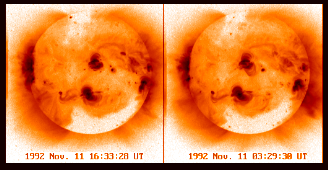
 |
Documentation > SXT Observation Notes > this page |
Image name: STEREO_PAIR.png (click image to enlarge)
Image size: 98.4060 KB (530x274)
Date submitted: 19-Feb-1994

A stereoscopic pair of SXT images, using solar rotation as a substitute for a deep-space observing platform. The time span of about 13 hours is close to what Dave Batchelor (NSSDC) finds to be about optimum for the strongest visual impression of three dimensions. To view this without optical aid, you need to be able to focus your crossed or diverged eyes and bring the two images into registration. For those who can, it is worth the effort - look, for example, at the filament cavity in the NW quadrant, and the sinuous structure to the S of it that winds around the W limb. Amazing. Acton points out that the filament cavity structure is so huge that hydrostatic effects could be causing the obvious brightness of the legs of the loops as opposed to their tops. Also please admire how well-defined the coronal holes appear to be in the stereo representation. Beware of places where real temporal changes have happened, e.g. at the S side of the N central active region or in most of the bright points. Submitted 19 Feb. 1994 by Batchelor and Hudson